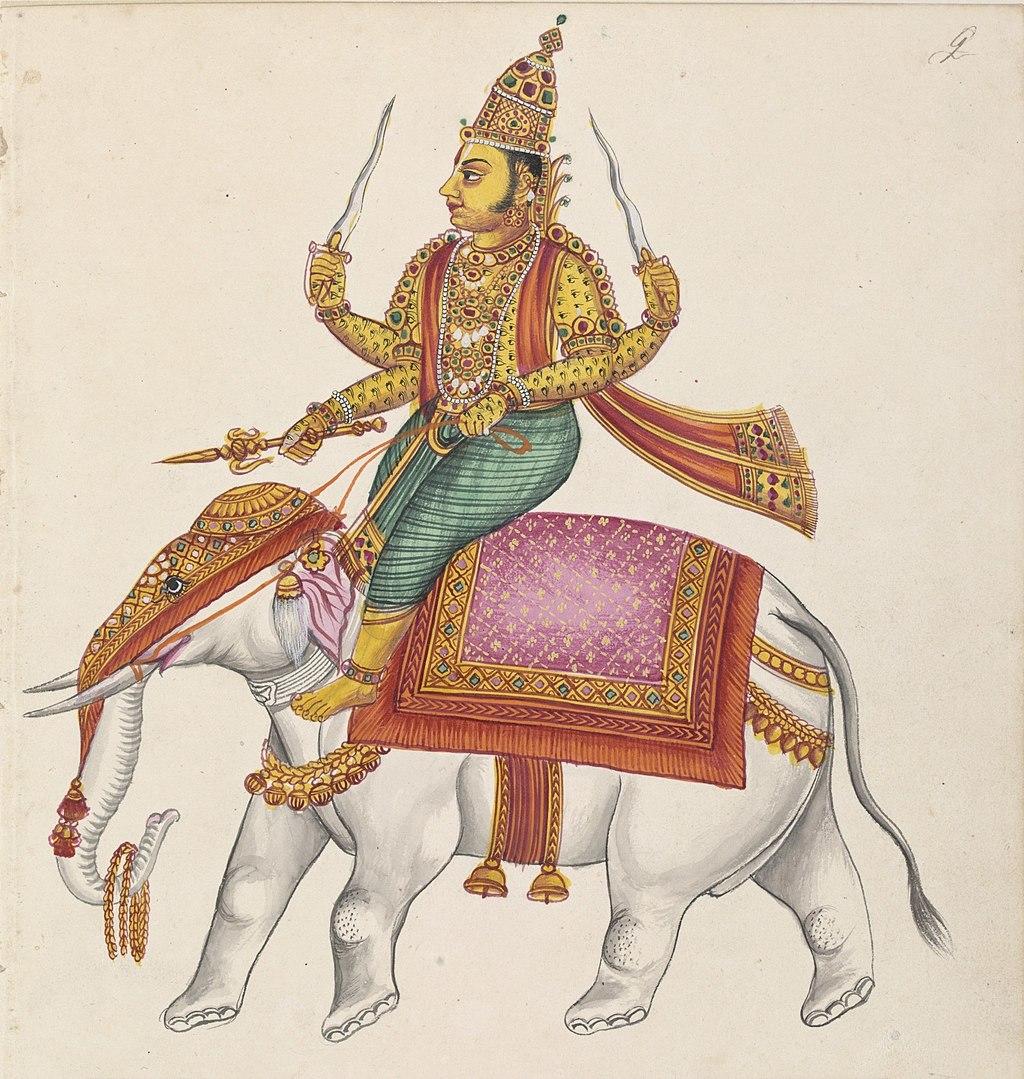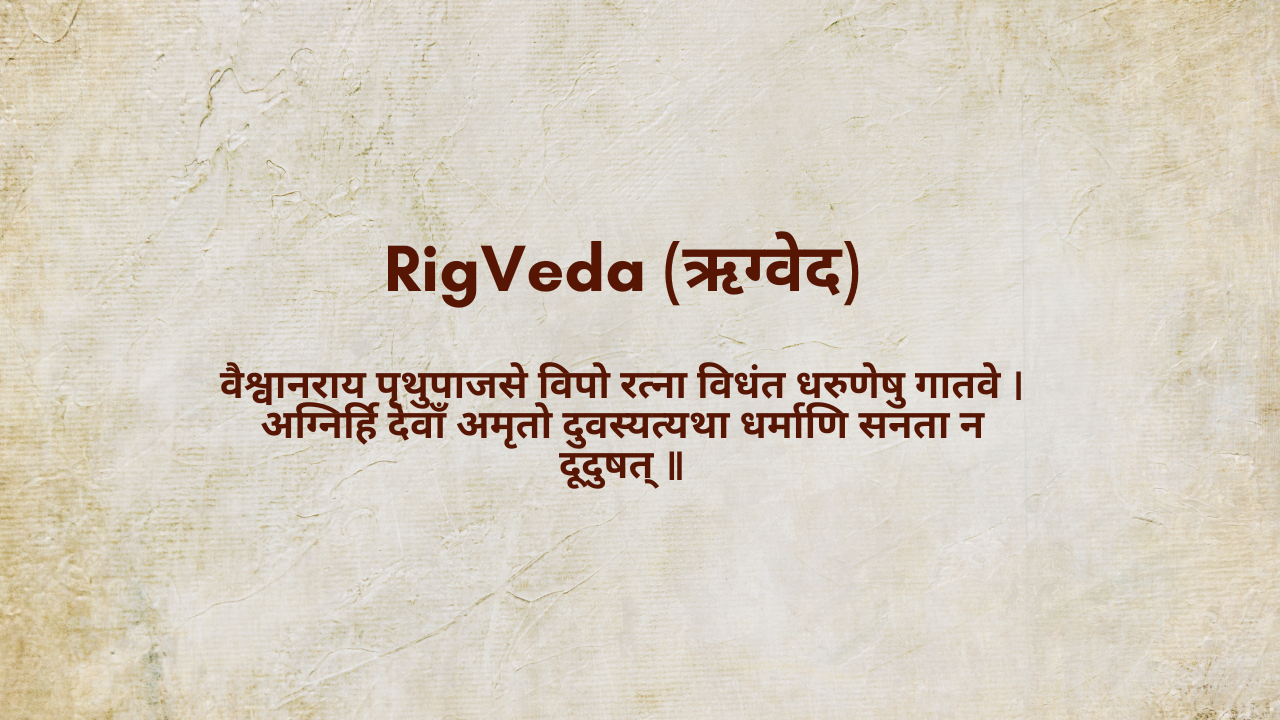What can an ancient text possibly teach people living in the modern age?
The Rigveda is the first in the series of the four Vedas and has been studied for thousands of years. It continues to be used in modern-day religious and spiritual studies, ceremonies, and rituals. Scholars, historians, and Hindu practitioners regularly refer to this ancient tome to learn about everything from religion to ancient society.
What are some of the lessons we can learn from the Rigveda, and how can you go about studying its pages yourself? Let’s learn about the basics of the largest Veda!

What Is The Rigveda?
The Rigveda is the oldest Veda of the four Vedas. Some Vedic scholars claim it was compiled (written) as early as 12,000 BCE, but more conservative estimates place it at around 1500 BCE. It’s also evident that different Mandalas of the Rigveda were written at different times and by different people. This is unsurprising because the very nature of the Vedas is collaborative and timeless.
In the Puranic tradition, it is believed that Ved Vyasa was responsible for compiling all four Vedas, as well as the Mahabharata and the Puranas. Vyasa then passed on the knowledge of the Rigveda samhita to Paila, who initiated the oral tradition.
It’s also one of the oldest texts in any Indo-European language! Although the original manuscripts didn’t survive to the modern day (due to the nature of the materials it was written on, like leaves and bark), the oldest existing texts date back to the 11th to 14th centuries.
It makes mention of the Samaveda and Yajurveda, meaning it was always intended to be part of a set of tomes.
“Rig” which is written as “rg” or “rk” means “verse,” and Veda means “knowledge.” The name Rigveda means “Praise of Knowledge.”
The most prominently praised god in the Rigveda is Indra, as 250 mantras are dedicated to praising him.
It is the first of all the Vedic texts, making it the first attempt in ancient Indian society to create a written guide to religion, spirituality, devotion, and everyday life. The Rigveda contains wisdom about many subjects, including the origin of the cosmos, how to worship gods and ask for blessings, as well as how to maintain health, and how to live a good life.
The Rigveda is sometimes referred to as Dashatayee, which means “having ten parts,” because it is comprised of ten mandalas.
The Rigveda names at least 21 Rishikas (female Rishis) as contributors to the text
"Sanatana Dharma" (सनातन धर्म) in the Rigveda 3.3.1
वैश्वानराय पृथुपाजसे विपो रत्ना विधंत धरुणेषु गातवे ।
अग्निर्हि देवाँ अमृतो दुवस्यत्यथा धर्माणि सनता न दूदुषत् ॥
vaishvAnarAya pRRithupAjase vipo ratnA vidhaMta dharuNeShu gAtave |
agnirhi devAN amRRito duvasyatyathA dharmANi sanatA na dUduShat ||
To him who shines afar, Vaisvanara, shall bards give precious thingthat he may go on certain paths: For Agni the Immortal serves the Deities, and therefore never breaks their everlasting laws.
The Teachings of the Rigveda
The wisdom of the Rigveda is considered to be Apaurusheya, that is, divine wisdom not influenced by the logic of humans and which is not to be attributed to any one author.
It was composed by hundreds or thousands of rishis over millennia in a completely verbal form before it was compiled and written down by Veda Vyasa.
Needless to say, the wisdom contained within the pages is timeless and has been used to help people live better lives for thousands of years. While some of the information might no longer apply to modern society in the same way it once did, millions of people continue to study the Rigveda to learn about life and the universe.
Indra is the most prominent deity, along with Agni, the sacrificial fire and messenger of the gods, and Soma, the ritual drink dedicated to Indra, as the other principal deities.
Invoking the Deities and the Elements
The vast majority of the mantras in the Rigveda are meant to invoke deities to ask for blessings. In fact, the very first word of the text is Agni, the god of fire.
Deities are used as personifications of natural phenomena like fire, rain, wind, lightning, and more. It is thought that invoking the deity of an element would allow you to ask for balance in that element, like less or more rain.
One could ask for blessings in the world around them or even for the balance of the elements within them. For example, if someone was suffering from fever, they could ask for less Agni, fire, within, so they could cool down.
The importance of Yajna/Yagna, ritual sacrifice in a fire, is mentioned as being an extremely important act. The different types of Yajna are elaborated in the Yajurveda, the Book of Rituals.
Every god is mentioned, either directly or indirectly, in the Rigveda. But, above all, Indira is mentioned as the primary deity in this text.
The Origin of the Universe
Believe it or not, this ancient text questions and explains the nature of reality, the origin of the universe, and the structure in the cosmos. This is especially amazing when you remember that the Vedas precede Heliocentrism in Europe by thousands of years, which didn’t gain traction until the 16th century!
The origin of the Universe, and the unifying energy in the Universe, is identified as being Bliss consciousness (Ananda).
These explanations and questions about the Universe even cross into existentialism territory when part of the Rigveda asks: Do even the Gods know the answer to our questions?
Yogic Principles
The Rigveda outlines some of the earliest forms of Yoga, although it doesn’t call these practices Yoga, since Yoga wasn’t invented yet!
Some of the foundations of yoga, like meditation, inner contemplation, and pursuit of spiritual harmony are mentioned in the Rigveda. It references pursuing mental discipline and a quest for higher consciousness.

Medicine
While diseases and medicine are much further explored in the Atharvaveda, the Rigveda also mentions certain diseases as well as medicinal herbs.
One of the most mysterious medicinal herbs in the Rigvega is Soma. It is a plant, a drink, and even a deity according to the Rigveda.
Is it a sacred potion fundamental in the performance of various Vedic sacrifices or rituals, however nobody knows what the exact plant or drink was. The potion is said to have granted immortality and was heavily used by the gods. One thing is certain: this drink likely had hallucinogenic effects.
But, whether Soma refers to a mushroom, a plant, or a combination of different ingredients is unknown.

The Structure of the Rigveda
The Rigveda is the largest book of all the Vedas. It contains 10,552 mantras, whereas the other three Vedas combined contain 9,948 mantras (for a total of 20,500 mantras in all four Vedas).
As with all the Vedas, four components make up the whole text: the Samhitas, the Brahmanas, the Aranyakas, and the Upanishads.
The Samhitas of the Vedas are typically what is being referred to when people talk about the information in a Veda.

When referencing text from the Rigveda, you’ll see it as such: (RV 4. 15. 1.). This is referring to the 1st Mantra of the 15th Sukta of the 4th Mandala.
Ways to Organize the Rigveda
There are two ways in which the mantras of the Rigveda can be organized: The Ashtaka Krama (order) and the Mandala Krama. The Mandala Krama is by far the most-used and most popular way to organize the Rigveda.
The Rigveda is organized as such because it helps disciples and scholars divide the information into smaller bits, making it easier to memorize.
It's important to note that mantras in the Rigveda are called rk, rg, or rik.
Ashtaka Krama
The rk / vargah / adhyaayah / Ashtakam scheme
"Ashtaka" refers to the number 8, the amount of major divisions in the Rigveda
- 5 or 6 rks form a vargah
- Several vargah form an adhyaayah
- 8 adhyaayah form an Ashtakam
- 8 Ashtakam form the Rigveda
Mandala Krama
The rk / sukta / Anuvaka / Mandala scheme
"Mandala" refers to a circle, perhaps the shape of the Rishis sitting in a circle together while they compile the books of the Rigveda
- Several rks form a sukta
- Between 43 and 191 suktas form an Anuvaka
- Between 4 and 24 Anuvakas form a Mandala
- 10 Mandalas form the Rigveda
The Ten Mandalas
The Mandalas are each revered for the way they were written. In reference to the Mandalas, special attention is drawn to the Kula/Kulam (clan) that wrote the Mandala. For example, the 2nd Mandala is called Grthsamada Kulam because it is believed to have been written only by Rishi Grthsamada and/or his disciples; it was not influenced by other people.
| Mandala | Composed By |
|---|---|
| 1 | Composed by many Rishis |
| 2 | Grthsamada Kulam |
| 3 | Vishvamitra Kulam |
| 4 | Vamadeva Kulam |
| 5 | Atririshi Kulam |
| 6 | Bharadwaj Kulam |
| 7 | Vashistha Kulam |
| 8 | Angira Kulam |
| 9 | Composed by many Rishis |
| 10 | Composed by many Rishis |
Classification of Rigveda
The Rigveda is divided into ten books (mandalas) which are further subdivided into anuvākas (sections) and sūktas (hymns).
The mandalas are not arranged chronologically but rather based on their length and content. The first four mandalas are the oldest and focus on hymns for the worship of gods, while the later mandalas contain more diverse subject matter and include hymns not addressed to specific deities.
Here is a summary of the 10 mandalas:
Mandala 1: The shortest with 191 hymns, covering a wide range of deities.
Mandala 2: The longest with 589 hymns, primarily dedicated to the worship of Indra, the god of thunder and rain.
Mandala 3: Contains 630 hymns, primarily focused on the worship of Indra, Agni (god of fire), and Soma (god of the intoxicating drink).
Mandala 4: Includes 583 hymns primarily dedicated to the worship of the Adityas, a group of twelve sun gods.
Mandala 5: Contains 875 diverse hymns addressing various deities.
Mandala 6: Includes 755 hymns primarily dedicated to the worship of the Maruts, a group of storm gods.
Mandala 7: Contains 1028 diverse hymns addressing a wide range of deities and non-specific deity hymns.
Mandala 8: Includes 1100 hymns primarily dedicated to the worship of the Aśvins, a pair of twin gods associated with healing and horsemanship.
Mandala 9: Contains 1067 hymns primarily focused on worship.
The Shakhas and the Brahmanas, Aranyakas, and Upanishads
The organization of the Rig Veda Samhita is sorted into recensions (editions, aka Shakhas); there were 21 but only 3 have survived to modernity:
- Shaakala
- Baashkala
- Shankhayana (less common)
Each Samhita has its own Brahmanas, Aranyakas, and Upanishads.
| Shakha | Samhita | Brahmana | Aranyaka | Upanishad |
|---|---|---|---|---|
| Shaakala | Shaakala Samhita | Aitareya Brahmana | Aitareya Aranyaka | Aitareya Upanishad |
| Baashkala | Kaushitaki Samhita | Kaushitaki Brahmana | Manuscript exists, no official name | Kaushitaki Upanishad |
| Shankhayana | Sankhayana Samhita | Shankhayana Brahmana | Shankhyana Aranyaka | included in the Aranyaka |
Influence of the Rigveda
The Rigveda is the most well-known and famous of the Vedas; even if someone doesn’t know anything about Vedic history, they have likely heard about the Rigveda.
The writings in the Rigveda have influenced classical Sanskrit poetry for thousands of years, shaping the language and stylings of an entire art form.
Historic Value
The Rigveda describes, in some sections, life in ancient India including outlining Aryan politics and traditions. It also talks about the Caste system, shining a light on what it was like to live during this period.
Famous Mantras
Some of the most famous mantras in the world are contained in the Rigveda.
First, the Gayatri Mantra, which is written in the 3rd mandala, is often used to invoke God and invite prosperity.
The other famous mantra is the Mahamrityunjaya Mantra, located in the 7th mandala. It is considered the most powerful Shiva mantra and is used to invoke all-around health and deter calamity.
Modern Philosophy
The Rigveda introduces the concept of Dharma, explaining how one can live a spiritually fulfilling life. This has influenced Hinduism and even other religions for thousands of years.
More recently, there has been a surge of interest in the West in Indian/Hindu concepts like karma and dharma, and so a new generation is learning about what it means to live a good life according to Vedic wisdom.
The Rigveda is the most well-known and largest Veda. While it’s well worth studying all the Vedas, if you could only choose one, this would be the one to study! It touches upon all the same concepts as the other three Vedas but is mostly used for learning about religious and spiritual philosophy.
References
- “Rigveda in English.” Mahakavya, 4 Apr. 2023, www.mahakavya.com/rig-veda-english/.
- “Rigveda.” Vedic Heritage Portal, vedicheritage.gov.in/samhitas/rigveda/.
- Skree. “The Vedas – Origin and Brief Description of 4 Vedas.” 108 House, 18 Oct. 2021, www.108.house/the-vedas-origin-and-brief-description-of-4-vedas/.
- “Veda Vyasa: The Sage Who Compiled the Vedas.” Hindu American Foundation, 21 Sept. 2020, www.hinduamerican.org/blog/veda-vyasa-the-sage-who-compiled-the-vedas.
- “What Is Rig Veda?” Yogapedia.Com, www.yogapedia.com/definition/5342/rig-veda.
- “Ṛgveda.” Hindupedia, the Hindu Encyclopedia, 8 Apr. 2023, hindupedia.com/en/%E1%B9%9Agveda.











